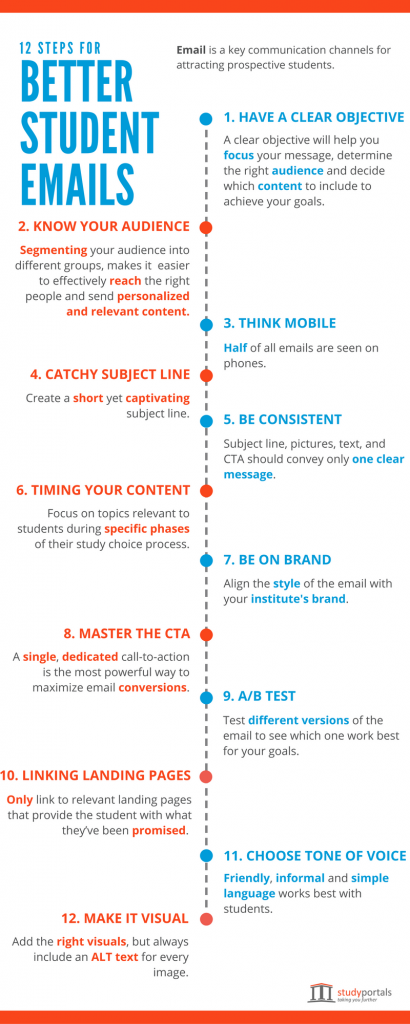12 steps to improve your student email marketing practices
If recruiting more international students is becoming a priority for your institution, understanding how to best communicate with them is critical to your strategy. Email is a key communication channel for attracting prospective students. At Studyportals, we interact with students via email on a daily basis, and based on those experiences, we would like to share 12 tips with you to improve your student email marketing practices:
1.Have a clear objective. Before starting to write an email, you should know what your main objectives are. By doing this, you will be able to have one focus, determine the right audience and best content for the goal you have in mind, whether that is to inform about an upcoming open day, to remind students of an upcoming application deadline or encourage students to apply for a specific study programme.
2. Know your audience. Nothing is more annoying than receiving an email that is not relevant to you. To increase engagement and effectiveness, think of the audience for your message. By segmenting your audience into different groups, it is easier to effectively reach a group by sending personalized content relevant for the recipient and only them.
3. Think mobile. As many of half of all our students browse our portals on their mobile phones, which is why all our emails are mobile friendly. Mobile has become an essential communication channel, and many students will open your email on their mobile devices. Therefore, it is of the essence that your content (text, pictures, visuals) are responsive to all types of screens, to prevent text from getting lost.
4.Think of a catchy subject line. Create a short yet captivating subject line. The subject line is the first thing students will see in their inbox. From the subject line students should get a clear indication what the email will be about. Therefore, ensure the subject line draws attention, is concise (under 7 words) but also personalized, and most importantly, relevant to the rest of the content in the email. It is advisable to include the name of your programme/university, city/country in the subject line.
5. Be consistent. Always make sure that the message you spread is consistent throughout the email, from subject line to the picture in the body, the content itself and the Call to Action. Within the education industry, it is advised and preferred to have forthright and clear messages that explain the purpose of the email without distracting too much from the content.
6. Timing your content. Focus on topics that are interesting and highly relevant to students during their search process, and share them at the right time. For example: discipline/program/course description are important for students in the early stages of making their study choice, while application process or entry requirements are more appropriate for students who have already shown an interest in your programmes. Anything that can bring a real value and help students to make their study programme decision.
7. Be on brand. When opening the email, students should be able to see who sent it in one glance. Therefore it is key to align the style of the email with your personal brand. For universities, adding images featuring real students from that university are most appealing to students.
8. Master the Call to Action. A single, dedicated call-to-action is the most powerful way to maximize your conversions. The CTA should be aligned with the main message you want to convey in your email and be the thing that stands out when the email is opened. It is best to not have more than one call to action button, as more can distract from the main purpose of the email.
9. A/B test your options. It is always useful to test different versions of the email you want to distribute to your students before distributing them to a larger audience, in order to see which options work best. There are several things you can test for its effectiveness, such as different subject lines, the call to action button, the visuals used or the timing of the email sent.
10. Linking the landing page. When adding a hyperlink to your website or a relevant page, it is important to add only relevant landing pages that provide the student with what they’ve been promised. When adding right and relevant landing pages, students will be more likely to continue browsing on your website and have a positive association when received further emails.
11. Consider the tone of voice. When addressing students, it is important to know which tone to use in order to get the right message across. Often, friendly, informal and easy language works best. Too much text will likely deter students from reading the email, and that means they might postpone reading it until a later time, or ignore it all together. CIt might be helpful to put yourself into students’ shoes and use language that you would use if a student was in your room at that point in time. Also, keep in mind that often, students interested in international education are not native speakers, which is why the language used should be simple and clear.
12. Make it visual. To make the email more attractive to students, it is important to add sufficient visual content to the email, in line with the general message and style. However, students will not always be able to load the email completely, which is why you should always have an alternative text, or an ‘alt text’ for every image added. In the case the image isn’t loading, the recipient can still understand the content of the image.
All in all, the key to addressing students is to keep it simple and to not overload the email with too much text. Make sure your email is personalized, to the point and significant. When in doubt, ask a student.
For more updates, follow us!






